Katana are not only beautiful weapons but also a fascinating piece of Japanese cultural history. In this article, we will answer some frequently asked questions about katana, covering all aspects from their history to their craftsmanship and usage.
Whether you’re an avid collector, a warrior, or simply fascinated by Japanese culture, this article provides you with a comprehensive look into the world of katana swords. Browse through the questions and answers and learn all about these unique weapons!
Katana FAQ
A Katana Sword is a traditional Japanese longsword originally developed for combat while on horseback. It is one of the most well-known swords in the world and is also recognized as the signature sword of Japanese samurai warriors. Katana swords are renowned for their sharpness and ability to effortlessly cut through steel. However, they are also renowned for their beauty and craftsmanship in manufacturing, considered masterpieces of traditional Japanese blacksmithing.
“The katana is not just a sword; it is an extension of the body and an embodiment of the samurai’s spirit.”
– Miyamoto Musashi
At KATANZO, you will find a wide selection of authentic katana, from beginner’s swords to high-quality collector’s pieces.
The production of katana in ancient Japan was a complex process that could take several months and required many different skills and techniques. Blacksmithing was highly developed in Japan, and the blacksmiths considered their work to be an art form.
The process started with choosing the right types of steel. Usually, multiple layers of different kinds of steel were forged together to create an alloy with the desired characteristics.
After that, the sword was forged, folded, and balanced multiple times to enhance its thickness and shape. During this process, the sword was also hardened and tempered to improve its sharpness and durability.
Following the forging, a polisher meticulously worked on the sword to enhance both its aesthetic appeal and functionality. The polisher employed various techniques to sharpen the blade, smooth the surface, and polish the sword’s exterior.
In the end, the sword, along with its handle and scabbard, was assembled to prepare it for use.
This was an elaborate process that demanded a great deal of time and skill, yet the result was a unique masterpiece that could fill the owner with pride.
“A master blacksmith is someone who infuses spirit into each piece of steel they craft.”
– Miyamoto Musashi
Katana at KATANZO are crafted by the award-winning swordsmiths at KAWASHIMA STEEL. For more details, check out our article “Where Are Our Swords Made?
The katana sword is an important part of Japanese culture and history, with a long tradition dating back to the 15th century. Originally, it was used as a weapon for samurai, the elite warriors of Japan, who were considered defenders of the emperor and the population.
Over the centuries, the katana sword was continuously improved and refined to enhance its sharpness, durability, and maneuverability. It became a significant symbol of samurai culture and an integral part of Japanese martial arts.
However, with the end of the feudal era and the transition to modern times, the katana sword lost its significance as a weapon and came to be appreciated primarily as an art object and symbol of Japanese culture and history.
“A katana is not just a sword; it is a piece of Japanese history and culture.“
Today, the katana is a highly sought-after collector’s item and a popular accessory for martial arts enthusiasts. At KATANZO, you can find a wide selection of high-quality katana for your collection or for use in training.
The katana sword was initially designed for use in both mounted and foot combat, primarily wielded with one hand, enabling quick and powerful strikes and cuts.
Over the centuries, an entire martial art centered around the katana sword also developed, known as Kendo or Iaido. These combat styles emphasize the swift drawing of the sword from its scabbard and a rapid, lethal strike to defeat the opponent.
Today, the katana is still utilized as a training weapon in many martial arts styles, including Kendo, Iaido, and Kyudo. It is also frequently employed as a prop in theater and film productions and is a sought-after collector’s item for enthusiasts of Japanese culture and history.
“The art of war involves not only the use of weapons but also the use of the mind and the heart.”
– Miyamoto Musashi
If you’re interested in traditional Japanese martial arts, owning a high-quality katana is a must. At KATANZO, you’ll find a wide selection of katana in various sizes and designs, perfect for training and use in Kendo or Iaido.
The word “katana” refers to a specific type of Japanese sword known for its length and short scabbard. It is a typical example of a samurai sword, but there are many other types of swords used by the samurai in ancient Japan.
A “samurai sword” is a more general term that encompasses all types of swords used by the Japanese warriors of the samurai class. This includes not only the Katana but also the Wakizashi (a shorter sword) and the Tanto (a dagger).
Together, these swords comprised the traditional equipment of a samurai. A samurai typically wore a katana at the side and a wakizashi as a backup weapon.
In summary, it can be said that a katana is a type of samurai sword, but not all samurai swords are katana.
At KATANZO, you will find a wide selection of Japanese Swords, including Katana, Wakizashi, and Tanto, all crafted with care and precision by skilled smiths.
Sharpening a katana requires skills and knowledge of traditional Japanese swordsmithing. Here are some basic steps to consider when sharpening a katana:
- Ensuring that the sword is clean and free from dirt and rust.
- Securing the sword to a stable work surface.
- Using a sharpening stone to sharpen the edge of the sword. It’s important that the sharpening stone has the right grit to achieve the proper finish.
- Drawing the sword over the sharpening stone in a smooth, even motion, making sure to maintain a consistent angle with the edge of the sword.
- Repeat the sharpening process on both sides of the sword until the desired sharpness is achieved.
- Perform a finishing touch with a finer sharpening stone to achieve a smooth and sharp edge.
Sharpening a katana is a complex task, and errors during sharpening can damage the sword or even render it unusable. It is advisable for a beginner to learn from an experienced smith or instructor how to sharpen a katana before attempting it on their own. If you are unsure about how to sharpen a katana, we recommend having it done by a professional smith.
“The sword is not sharp; it is ready.”
– Miyamoto Musashi
The length of a traditional katana can vary significantly and depends on various factors such as the smithing tradition or technique. However, it is common for the blade of a katana sword to be longer than the handle. The overall length of a katana sword does vary, but it is typically around 100 cm.
At KATANZO, katana have a standard length of 40.5 inches (103 cm), including the handle.
The value of a katana depends on various factors such as its age, the quality of craftsmanship, the reputation of the smith, its condition, and the uniqueness of the sword. There are katana that can be sold for less than $100, but there are also katana that can be sold for thousands or even hundreds of thousands of dollars.
KATANZO’s katana offer unbeatable value for money and are available in various price ranges to cater to every budget. Additionally, KATANZO provides a Custom Katana Configurator that allows customers to design their own custom katana at a reasonable price.
There are many different brands that manufacture katana, and it depends on what type of katana you are looking for and how much you are willing to spend.
If you are looking for a brand specializing in hand-forged katana, KATANZO® could be a good choice, as we have been focusing on the manufacturing of Japanese swords for over 20 years and offer an extensive range of different types of katana, including High-End Katana and individualized Custom Katana.
A katana sword is traditionally held with both hands, with the left hand gripping the handle and the right hand holding the handle and wielding the blade. An important aspect of holding a katana is maintaining good posture, which means standing upright and keeping the shoulders relaxed to maintain good control over the sword. If you are a beginner, it is advisable to have an experienced sword expert or teacher show you how to properly hold a katana.
The forging time of a katana sword varies depending on its size, design, and forging technique. A traditional katana can take several months to be fully forged and crafted. It is a highly intricate process where each individual component is carefully created.
At KATANZO, katana are forged with the same care and dedication as traditional Japanese swords. The forging time depends on the size and design of the katana. However, our Katana Online Shop offers a wide selection of pre-forged katana that are available immediately, as well as a Custom Katana Configurator where customers can create their own custom sword.
Yes, a katana can also be used as decoration. Many people collect or decorate their living spaces with katana to showcase their passion for Japanese culture and sword culture. However, it’s important to note that a katana, whether used as artwork or as a protective weapon, is a deadly weapon and should be handled with care.
Katana were originally used as weapons for the warrior caste of the samurai in feudal Japan. They served for defense and as a symbol of the warrior’s status. Throughout history, they were also used in daily life and ceremonies. Although katana are primarily considered collector’s items and works of art today, they still remain a part of Japanese culture and history.
“The katana is not just a sword but an embodiment of strength, honor, and craftsmanship.”
Katana were originally used as weapons for warfare and self-defense. However, in the modern world, they are more commonly known as works of art and collector’s items. Some people use them for traditional sword fighting such as Kendo, but it is unlikely that they would be used in modern military or sports combat as they do not meet the same safety and protection requirements as modern weapons.
It’s important to note that katana are legally regulated as weapons in many countries, and it may be illegal to possess or use them without the necessary permits and licenses.
The handle (tsuka) is an important part of the katana sword as it represents the connection between the sword and the swordsman. A well-designed tsuka should fit comfortably in the hand and provide a secure grip. The tsuka is often wrapped with a series of fabric or leather cords (tsukamaki) which not only increase the stability of the handle but also add individual aesthetics. In some cases, the tsuka can also be adorned with inlays, ornaments, or other decorations to enhance the katana’s appearance.
Katana are sturdy swords that can last a long time under the right conditions. However, the lifespan of a katana depends on many factors, such as the quality of craftsmanship, maintenance and storage of the sword, as well as the frequency and type of use. A well-maintained and carefully crafted katana can endure for generations. However, it’s important to note that katana are not tools for everyday use and should primarily serve as works of art or collector’s items.
In ancient Japan, the steel for katana blades was often folded multiple times to achieve high hardness and toughness. This method was necessary because the available steel types at that time were not as high-quality as today. In modern times, there are advanced methods to achieve high hardness and toughness without the need for folding the steel for katana blades multiple times.
More information about folded steel or not is available in our article “Folded Steel or Not?”
Yes, a high-quality katana is capable of cutting through thin steel. The katana was originally designed as a weapon for close combat and should, therefore, be able to cut through harder materials like steel. However, it’s important to note that cutting through steel is a very demanding task and the ability of a katana to do so depends on its sharpness, hardness, and construction.
The katana is curved because this shape is a result of the forging technique, especially the clay tempering. This technique involves using clay and heat to create a hard core (ha) and a soft outer layer (mune) on the blade. These two layers have different hardness levels, resulting in a curved shape that provides optimal properties for cutting power and flexibility.
The curved shape also facilitates drawing the blade from the scabbard, which was of great importance to samurai warriors.
Also interesting is the article: “What Is a Clay Tempered Blade?‘”
Katana can be purchased at various stores and online shops specializing in collectibles and historical weapons.
A particularly good option for purchasing a high-quality katana is KATANZO. Our Online Shop for Japanese Swords offers a wide selection of traditionally crafted katana as well as modern variants. Customers can customize their own individual katana using the Custom Katana Configurator. Each sword is carefully crafted by experienced blacksmiths and meets the highest quality standards.
General questions and answers about our online shop and the ordering process can be found in our Frequently Asked Questions.






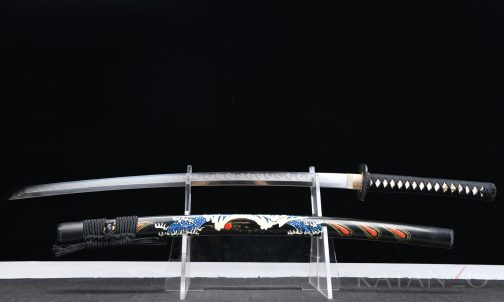
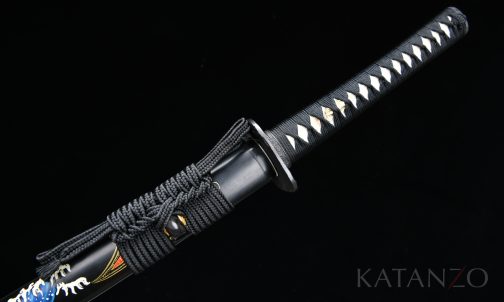
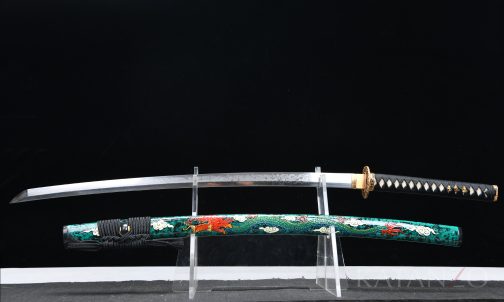
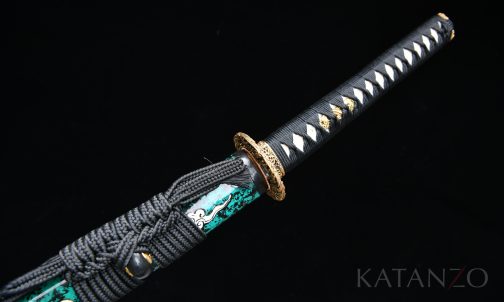








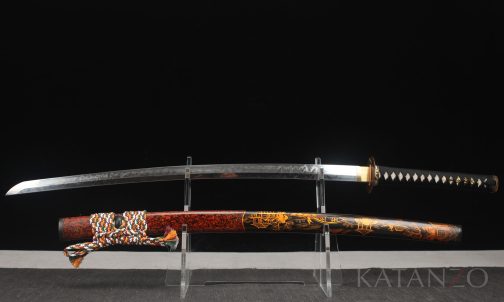
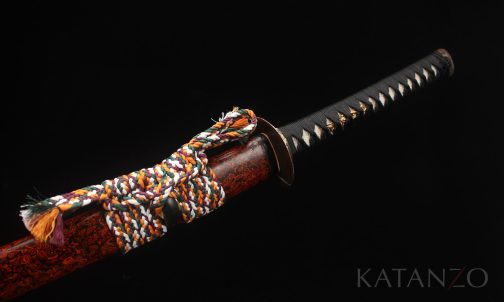
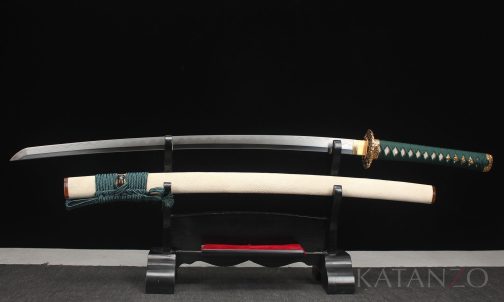


Katana from our shop:
Katana “Doragon no Hi”
Katana “Kogane no Doragon”
Katana “Mitsuri”
Katana “Roiyaru Tonbo”